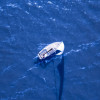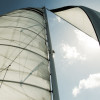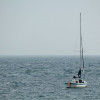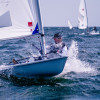Learn to Sail
Sailing consists of five fundamental skills to be learned independently, then used in conjunction. Here, you'll learn what those skills are and how to master the fundamentals.
Getting started
If you don't know where to start and simply want a clear overview of the skills involved and freely available resources on our website, we recommend starting with reading this beginner's guide explaining step by step what skills you'll need to acquire and how to go about doing it.
More on getting started
Handling the sails
Before you can trim your sails you must set sail. To set sail, you must raise them first.
Raising and reefing your sails are one of the most essential skills to sailing. Once you know how to do set up your different sails, you'll be ready to set sail for the first time.
Sail trim
Sail trim consists of shaping the sails appropriately to the point of sail (or relative wind direction to your boat). How well you master sail trim will determine your speed above all else.
Trimming your sails appropriately isn't rocket science, and you will develop an intuition for it over time. But before intuition comes knowledge, which you'll get by reading our guide on trim here.
Anchoring
Anchoring is one of the critical sailing skills and requires some basic knowledge of how anchors work, what types there are, and what ways you can drop them. All of which will be explained in detail in our anchoring hub.
Navigation
Marine navigation is an extensive skillset consisting of many different individual skills. We've created a detailed navigation hub which will walk you through each of the skills and how to learn them.
Weather interpretation
The most critical decision you'll make regarding your sailing will be onshore.
Wind is the most important factor in sailing, both in determining your ultimate speed, and comfort and safety. Knowing at what wind speeds you're comfortable, and at which speeds you start worrying (and acknowledging this to yourself), is the most important decision you'll make, and you'll make it before you board your boat and head out.
Knowing the current actual wind speed is even one step before that one.
Reading weather charts
Next you'll need to be able to get your hands onto weather charts, and know how to read them.
Reading tidal charts
Coastal sailing comes with another dimension that is critical too. Knowing the tides is as important as knowing your exact location. Coastal waters often contain plenty of shallows and the lower the tide the more problematic they can become.
The easiest way to avoid running aground is having local tidal charts at your disposal and being able to read them correctly.
More on weather interpretation
Sailing solo
Also called single-handing
Sailing solo makes things more complicated but there are many systems you can use to sail even larger boats alone. Perhaps more important is what boat you choose, and your level of experience.
Sailing terms
In this illustrated guide, we've filtered out the most important sailing jargon and explained and illustrated them with text and pictures. This is a great resource for beginning sailors that need an overview of the most important sailing terms without drowning in it.
Essential sailing knots
To sail is to tie knots. The more appropriate your knots, the more enjoyable the experience will be. Strong knots for lines under load, easy-to-undo, but secure knots for docking (ahum bowline), and so on.
Getting started
If you don't know where to start and simply want a clear overview of the skills involved and freely available resources on our website, we recommend starting with reading this beginner's guide explaining step by step what skills you'll need to acquire and how to go about doing it.
More on getting started
Handling the sails
Before you can trim your sails you must set sail. To set sail, you must raise them first.
Raising and reefing your sails are one of the most essential skills to sailing. Once you know how to do set up your different sails, you'll be ready to set sail for the first time.
Sail trim
Sail trim consists of shaping the sails appropriately to the point of sail (or relative wind direction to your boat). How well you master sail trim will determine your speed above all else.
Trimming your sails appropriately isn't rocket science, and you will develop an intuition for it over time. But before intuition comes knowledge, which you'll get by reading our guide on trim here.
Anchoring
Anchoring is one of the critical sailing skills and requires some basic knowledge of how anchors work, what types there are, and what ways you can drop them. All of which will be explained in detail in our anchoring hub.
Navigation
Marine navigation is an extensive skillset consisting of many different individual skills. We've created a detailed navigation hub which will walk you through each of the skills and how to learn them.
Weather interpretation
The most critical decision you'll make regarding your sailing will be onshore.
Wind is the most important factor in sailing, both in determining your ultimate speed, and comfort and safety. Knowing at what wind speeds you're comfortable, and at which speeds you start worrying (and acknowledging this to yourself), is the most important decision you'll make, and you'll make it before you board your boat and head out.
Knowing the current actual wind speed is even one step before that one.
Reading weather charts
Next you'll need to be able to get your hands onto weather charts, and know how to read them.
Reading tidal charts
Coastal sailing comes with another dimension that is critical too. Knowing the tides is as important as knowing your exact location. Coastal waters often contain plenty of shallows and the lower the tide the more problematic they can become.
The easiest way to avoid running aground is having local tidal charts at your disposal and being able to read them correctly.
More on weather interpretation
Sailing solo
Also called single-handing
Sailing solo makes things more complicated but there are many systems you can use to sail even larger boats alone. Perhaps more important is what boat you choose, and your level of experience.
Sailing terms
In this illustrated guide, we've filtered out the most important sailing jargon and explained and illustrated them with text and pictures. This is a great resource for beginning sailors that need an overview of the most important sailing terms without drowning in it.
Essential sailing knots
To sail is to tie knots. The more appropriate your knots, the more enjoyable the experience will be. Strong knots for lines under load, easy-to-undo, but secure knots for docking (ahum bowline), and so on.
























